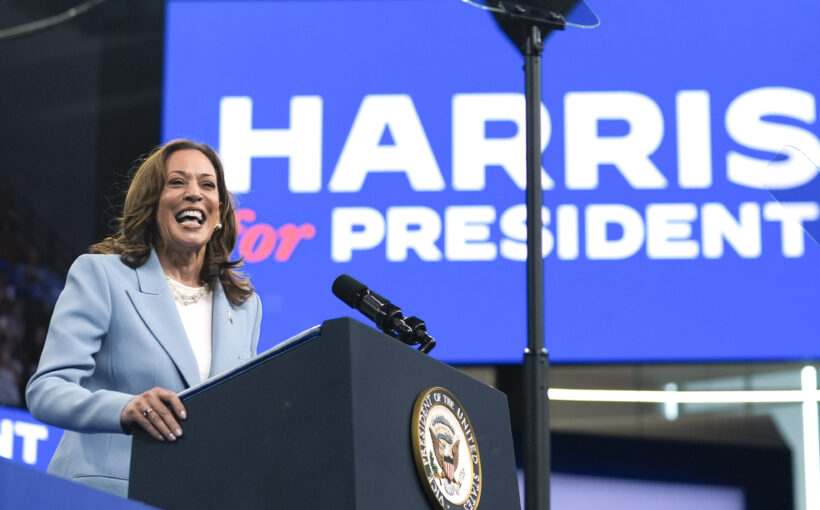
Now that the dust has settled after the first and perhaps only presidential debate between Vice President Kamala Harris and former President Donald Trump, the state of the polling looks clear: Harris has a slight edge in a race that remains extremely close.
Harris leads national polls, on average, by 2 or 3 percentage points. More importantly, she leads in the key electoral college states of Michigan, Wisconsin, and Pennsylvania by 1 to 2 points in recent polling averages. And if she wins all three, that would be just enough to give her the presidency (so long as she holds onto the other blue states, and Nebraska’s Second District).
But it’s important to remember that a 1 or 2 point lead in polling averages is not a safe or reliable lead. A polling error underestimating Trump in these states — of the sort that occurred in 2016 or 2020 — could send Harris to defeat.
As for the other swing states: Nevada has had few high-quality polls since the debate, but the averages currently show a very close race, with Harris leading by a point or less. But Trump has a slight lead — 2 points or less — in the averages for North Carolina, Arizona, and Georgia.
The big picture, though, is that all seven of the swing states are close enough in polls that they could easily go to either candidate.
The New York Times/Siena polls have shown some unusual results
Though the news for Harris in post-debate polling has generally been good, some results from the New York Times/Siena College polls tell a more complicated story.
This polling found Harris up by 4 points in Pennsylvania, the most important swing state, which is fantastic for her. But it also showed a tied race nationally — and larger than average Trump leads in North Carolina (3 points), Georgia (4 points), and Arizona (5 points).
Typically, the best practice for looking at campaign polling is to throw it all into an average, since any one pollster’s results could be an outlier. But the Times polls are highly respected in political circles, so it may be worth contemplating what it would mean for the race if their recent polls turned out to be accurate.
One takeaway is that though those polls are generally worse for Harris, the Pennsylvania result is actually quite good — better than average. Overall, the Keystone State polling has not looked great for Harris since she entered the race, leading to many takes about her purported Pennsylvania “problem,” second-guessing about whether she should have picked the state’s governor, Josh Shapiro, as her running mate, and a belief that the Electoral College math gives Trump an advantage.
The Times polls, however, essentially point to a parallel world in which Electoral College bias doesn’t help Trump, and may even help Harris significantly. The Times has not polled Wisconsin or Michigan this month, but their polling of the states last month showed Harris up in those states — and in Pennsylvania — by 4 points.
Why would this be the case? Nate Cohn, the Times’ chief political analyst, has actually written since last year that Trump’s Electoral College edge might be fading. That could be because Republicans have gained ground in heavily blue states, like New York, but they’re still nowhere close to actually flipping those states — while Democrats have held on in the battleground states. The 2022 midterm results appear to be consistent with such a theory.
For Biden in 2020, the decisive Electoral College state was Wisconsin, but his margin was nearly 4 points worse there than his national margin, a serious gap. For Harris this time around, polling averages have tended to show a smaller disadvantage — but they have typically shown her performing a bit worse in the pivotal state, Pennsylvania, than she does nationally.
The Times polling is unusual, though, in implying that the bias may go in the other direction this time around; that the Electoral College might actually help Harris. For now, this is an outlier result, but it’s certainly an interesting scenario.
A less encouraging takeaway for Harris if the Times polls are accurate is that Trump has the advantage in Georgia, Arizona, and North Carolina. Other pollsters have also typically shown Trump with a narrow edge in those states, but the Times polls may be ominous, showing him with a 3-5 point advantage in them all, just after Harris’s well-received debate performance.
If those states prove out of reach for Harris, she’ll be stuck relying on Pennsylvania, Wisconsin, and Michigan as her only path to victory — the same “blue wall” Hillary Clinton hoped in vain would save her in 2016. Winning them, but not the other swing states, would put Harris at the narrowest possible 270 to 268 Electoral College victory. What could go wrong?



